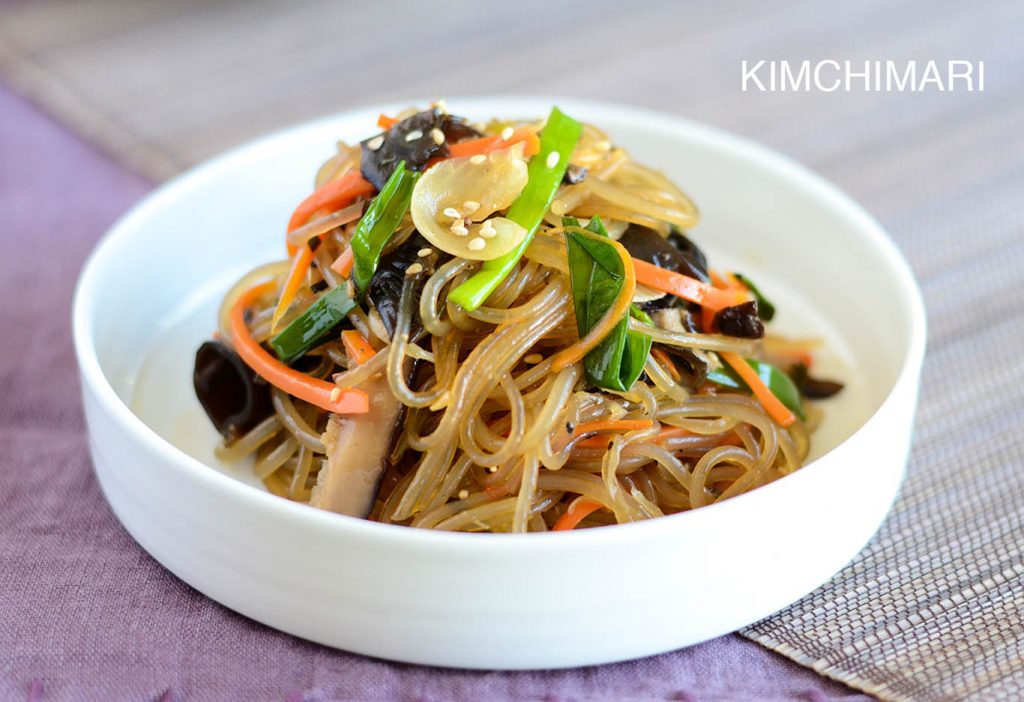
Korean Glass Noodles (Japchae 잡채) made in 20 minutes!!?? Well, kind of.. 😜 To be precise, it’s 20 minutes of cooking time but the noodles have to be soaked in water for 2 hours or so prior to cooking. However, you can also soak the noodles overnight so that’s almost no time as long as you plan ahead, right??
This one-pan Korean Glass Noodles/Japchae recipe is also vegan, gluten free and most of all, just as delicious as the full authentic Japchae recipe. FYI, I’m assuming you are using soy sauce that’s gluten free. Good quality, naturally brewed Korean soy sauce is naturally gluten free. Read my Know your Korean Soy Sauce post for more info.
In my experience, everyone loves Japchae – Koreans and non Koreans alike. But, if you ask any Korean mom whether they make Japchae often, this is probably what they will answer –
“Oh, Japchae!…Yes, it is soo good and my family loves Japchae but.. it takes just too much work…so I just don’t get to make it very often..”
And honestly, I would be lying if I said that I made Japchae all the time. As much as I LOVE the dish and as much as I hate the ones served at most restaurants, I just don’t make it often enough. I think I already ranted about how bad restaurant Japchae is in my previous Japchae post so read it there if you want to know how bad I think they are..hahaha.
Sadly, I just can’t get myself to make Japchae at home very often because yes, it is a LOT of effort and time for just ONE dish. But if you make it right, OH MY, it’s sooo yummy with the perfectly chewy but soft glass noodles coated with wonderfully balanced, subtle flavors of soy sauce, sesame oil and a hint of sweetness. And in between the perfect noodles, the vegetables and meat add such a wonderful variety of flavors and texture.
In the ol’ days when Korean mothers cooked instead of ordering food for special holidays like Korean New Year’s and Chuseok, a properly home made delicious Japchae was always, I mean ALWAYS, on the table.
These days, very few Koreans make this wonderful Korean Glass Noodles or Japchae at home whether they live in Korea or abroad. And as I said, most restaurants only serve the very minimal Japchae version because it’s usually served as side dishes which means they need to save time and money in making it. I sometimes worry that the authentic flavors of the wonderfully home made Japchae will be lost over time… Hopefully this recipe will inspire you to make some Japchae for your family today and also inspire my daughter J to make some Korean Glass Noodles for her own family someday~ ❤
So, until now, I had no alternative recipe that was easy and simple enough to cook frequently at home that still tasted just as good as the full traditional Japchae recipe (which is gloriously good if you have the time). That’s a pretty tall order, I think. But, guess what?? I think I have done it!!
And I must say — I’m pretty proud of this one!! 😉
I started out actually trying to make the Chinese-Korean version of Japchae that you can get from any Korean Chinese restaurant in Korea. It is usually served as Japchae Bap (잡채밥) and it is a quick stir fried version of Japchae that has more liquid which makes it go well with rice. However, there is something about this Japchae that I don’t like very much – it usually comes too overly fried, too greasy or too muddled in flavor.
This simplified yet still just as authentic tasting Korean Glass Noodles recipe in this post is actually very similar to the traditional version except the noodles are probably a little chewier and does not have meat. This Korean Glass Noodles or Japchae recipe is thus vegetarian, vegan, gluten free and is still just as good as my traditional recipe but in less than 1/2 the time – in just 20 minutes!
Korean Glass Noodles (당면 Dangmyeon)
- Korean Glass Noodles (당면 Dangmyeon) are made from 100% sweet potato starch. So it’s naturally gluten free. Dangmyeon basically belongs to the category of Cellophane Noodles which can also be found in Chinese, Thai, Vietnamese and other Asian cuisines. Dangmyeon is not as white or and not as transparent as other cellophane noodles and is more chewy than most. What’s really confusing is how Korean companies use different English names for it – Glass Noodles, Starch Noodles, Sweet Potato Noodles, Vermicelli…sigh… So, just look for the Korean word 당면 and do not confuse it with 냉면 (Naengmyeon) because they are both straight and brownish looking noodles. Dangmyeon is usually sold in much bigger packages, is thicker than naengmyeon and is more squiggly.
Shitake Mushrooms (Pyogo Beoseot 표고버섯)
- Dried Shitake mushrooms have so much more flavor than fresh mushrooms so try to use dried ones if you can. The flavor of this exquisite mushrooms really makes this dish. Shitake mushrooms are often used as meat substitutes in Korean temple food due to its meaty flavor and texture.
Wood Ear/Jew’s Ear/Jelly Ear Mushrooms (Mogi Beoseot 목이버섯)
- The scientific name for Mogi Beoseot or wood ear is Auricularia auricula-judae. I love the texture of this mushroom. It has a soft rubbery texture – not too chewy but adds great bite to any dish. Wood ear mushroom can be most commonly found in Chinese hot and sour soup – it’s the thin slivers of black chewy pieces in the soup. Wood ear mushrooms do not have a big flavor but the texture does not change with cooking so it is a great addition to various dishes like Korean Japchae and soups. Mostly, they are sold in dried state but you can also find fresh ones in some areas. It is also known to have some great health benefits such as lowering bad cholesterol and having anticoagulant properties so it’s a great addition to your diet.
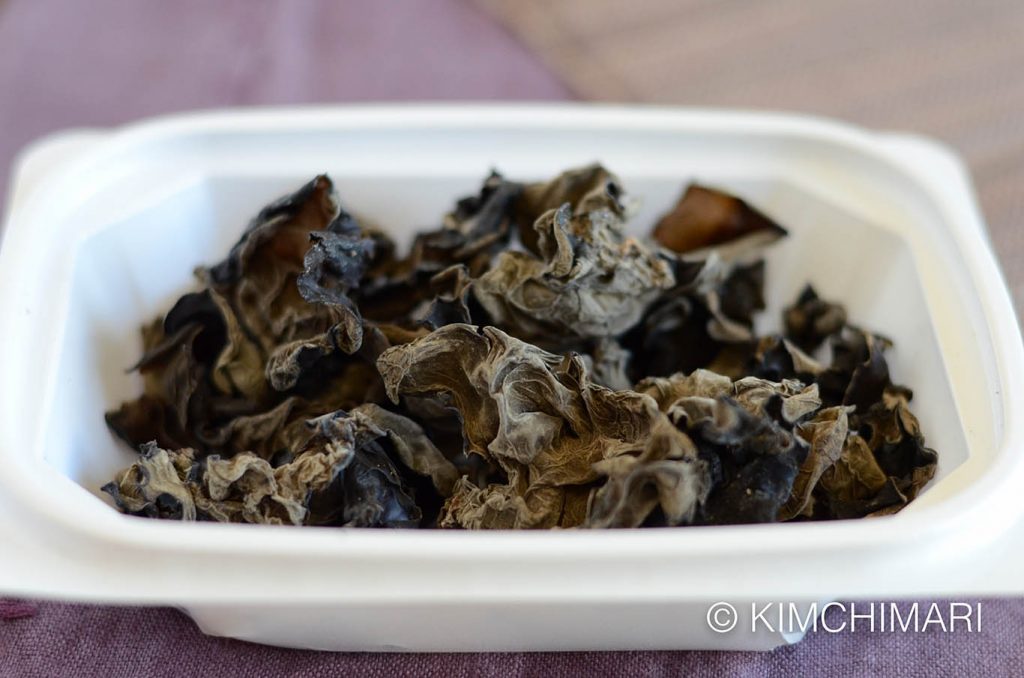
Dried Wood Ear Mushroom (Mogi Beoseot 목이버섯)
Simple one-pan Korean Glass Noodles (Japchae)
Servings 4 Inactive Time: 2 hrs Cook Time: 20 min Difficulty: Medium
Ingredients
- 7 oz (200g) dry Korean Glass Noodles (당면 Dangmyeon) – doesn’t have to be exact
- 8 dried Shitake mushrooms (3/4 cup fresh shitake mushrooms, sliced)
- 1 cup carrots, julienned
- 1 small onion, thinly sliced
- 6 green onions – cut 4 green onions into 2 inch (5 cm) lengths and chop 2 green onions
- 1 cup fresh wood ear mushrooms (Mogi Beoseot 목이버섯) or 10g dried wood ear mushrooms
- 2 Tbs vegetable oil
- Marinade for Shitake mushrooms
- 2 tsp dark soy sauce (jin ganjang 진간장), for Gluten Free, use soy sauce like Tamari
- 1 tsp rice wine
- 1 tsp garlic, chopped
- 1 tsp sugar
- ½ tsp sesame oil
- dash of black pepper
- Sauce for Japchae
- 3 Tbs dark soy sauce (jin ganjang 진간장)
- 1 Tbs + 1 tsp sugar
- 1 Tbs rice wine or mirin
- 1 Tbs sesame oil
- 1 Tbs sesame seeds
- 2 Tbs Shitake mushroom water from hydrating mushrooms (substitute plain water if using fresh mushrooms)
- Soak Korean glass noodles (Dangmyeon or Vermicelli) and any dried mushrooms in room temp water for 2- 3 hours. You can also soak both mushrooms and glass noodles overnight. Soak in fridge in warm weather.
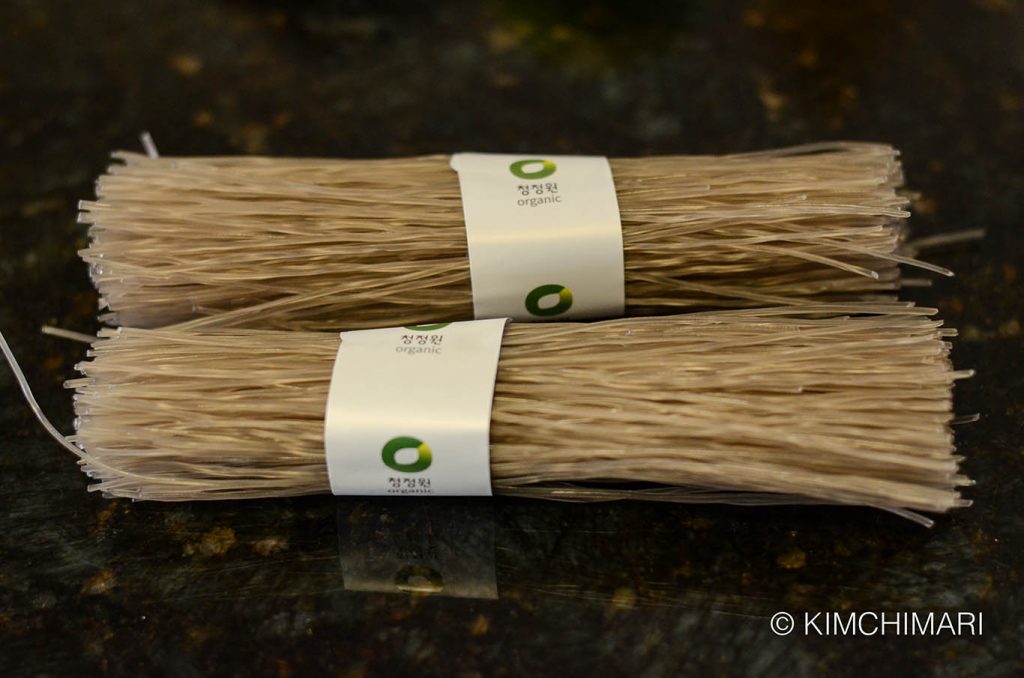
Korean Glass Noodles (당면 Dangmyeon) – each bundle is about 100g (3.5 oz) - Clean and cut other vegetables: julienne carrots, onions and cut green onions into similar lengths as carrots and onions. Split the green onion lengthwise in half if the white part is thicker than a pencil.
- When mushrooms are fully reconstituted, rinse and clean the mushrooms. When cleaning wood ear mushrooms, make sure the bottom part are free of dirt and white matter by rubbing all of it off with your fingers.
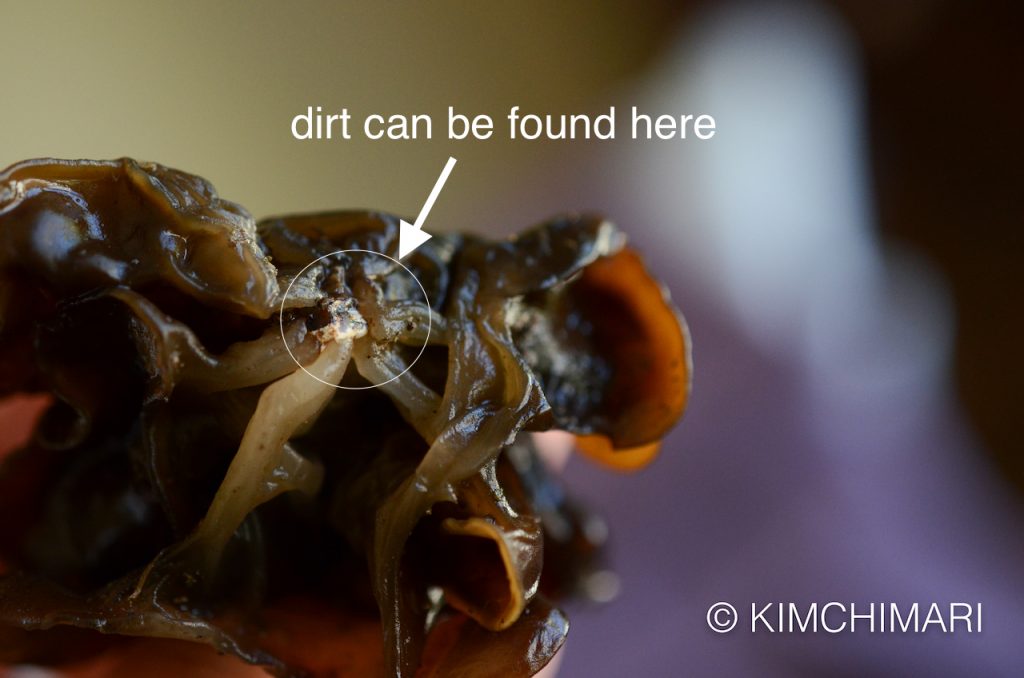
Clean bottom of Wood Ear Mushroom (Mogi Beoseot) - Drain and squeeze any excess water from Shitake mushrooms. DO NOT DISCARD mushroom water. Save 2 Tbs of mushroom water for later. Do not squeeze the mushrooms too much, just one gentle squeeze with your hands is good enough. Enough so that mushrooms are not dripping water.

Rehydrated Shitake Mushrooms (different sizes), squeezed to remove excess liquid for Japchae - Cut Shitake mushrooms into thin slices. Cut wood ear mushrooms into bite size pieces (size of quarters).
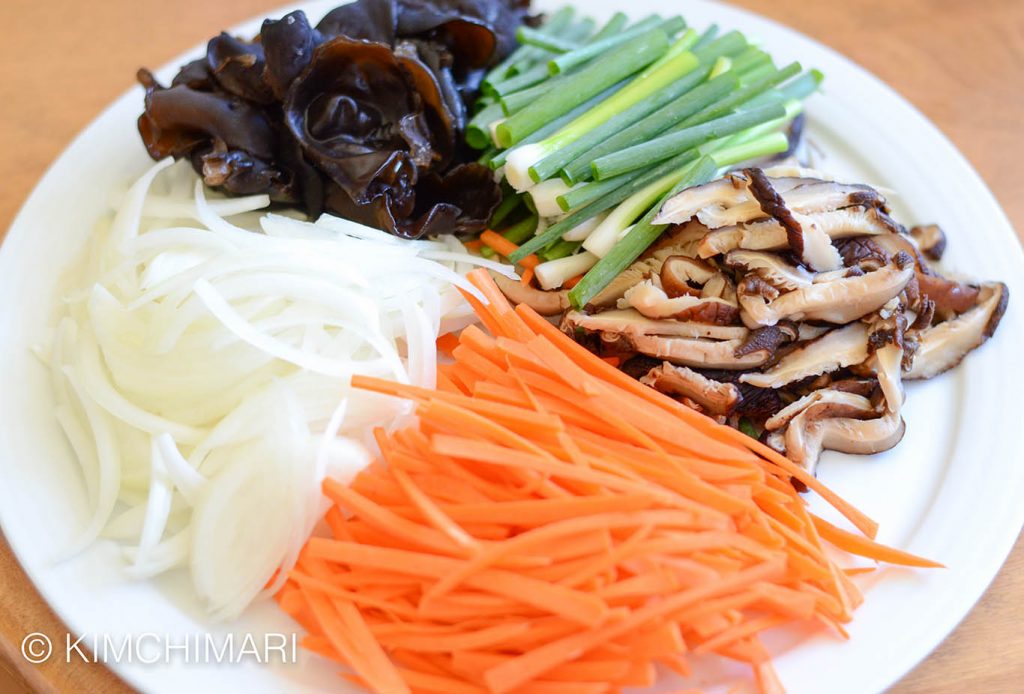
Japchae ingredients of onions, carrots, 2 kinds of mushrroms and green onions for vegan one-pan recipe - Marinate Shitake mushroom slices with soy sauce, rice wine, garlic, sugar, sesame oil and black pepper.
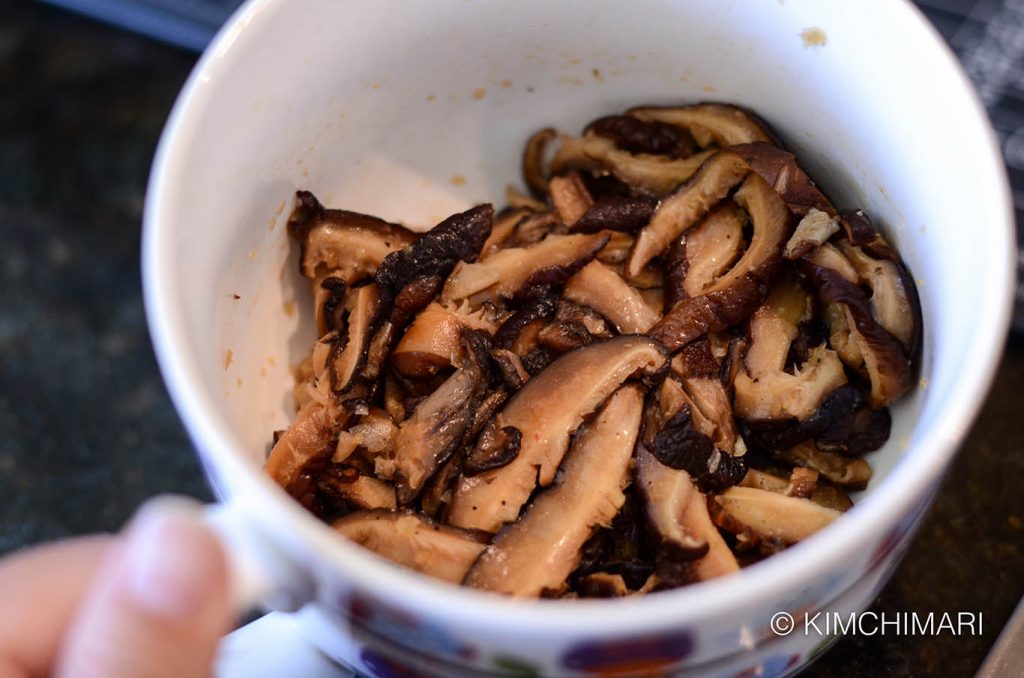
Marinated Shitake Mushrooms for Japchae - Make sauce for Korean Glass Noodles by mixing everything in a bowl except mushroom water. Set aside.
- Drain glass noodles and set aside.
- Heat 2 Tbs of vegetable oil on medium high heat in a wok or deep stir-fry pan and stir-fry chopped green onions (about 2 Tbs) for 30 seconds or until cooked but not browned.
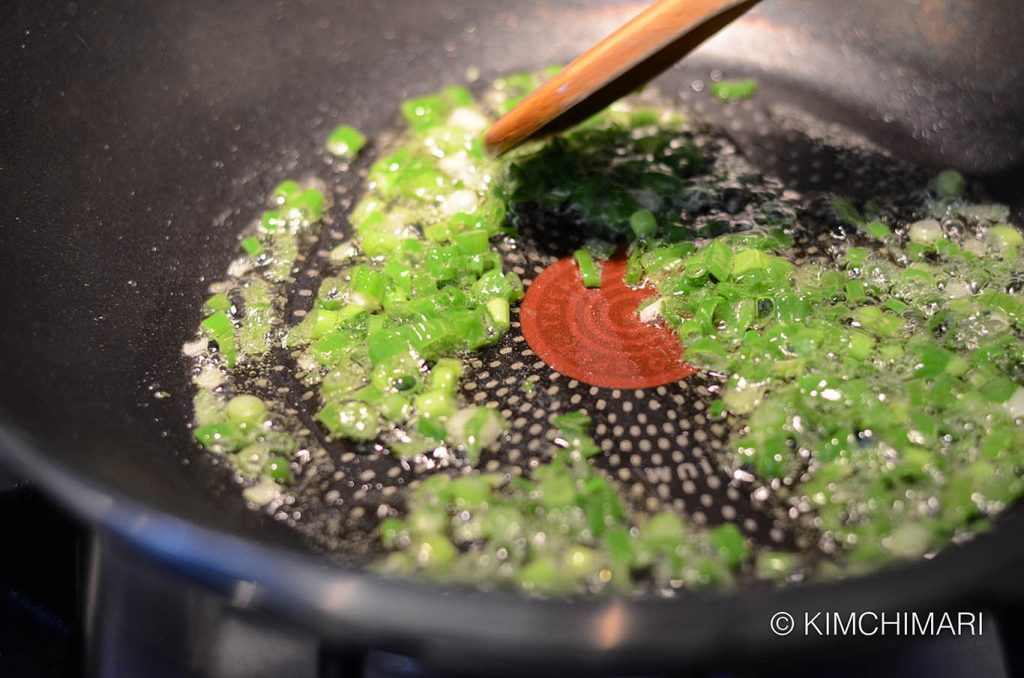
stir-frying green onion in oil for one-pan Korean Glass Noodles Japchae - Add marinated Shitake mushrooms to pan and stir-fry for 30 seconds or so.
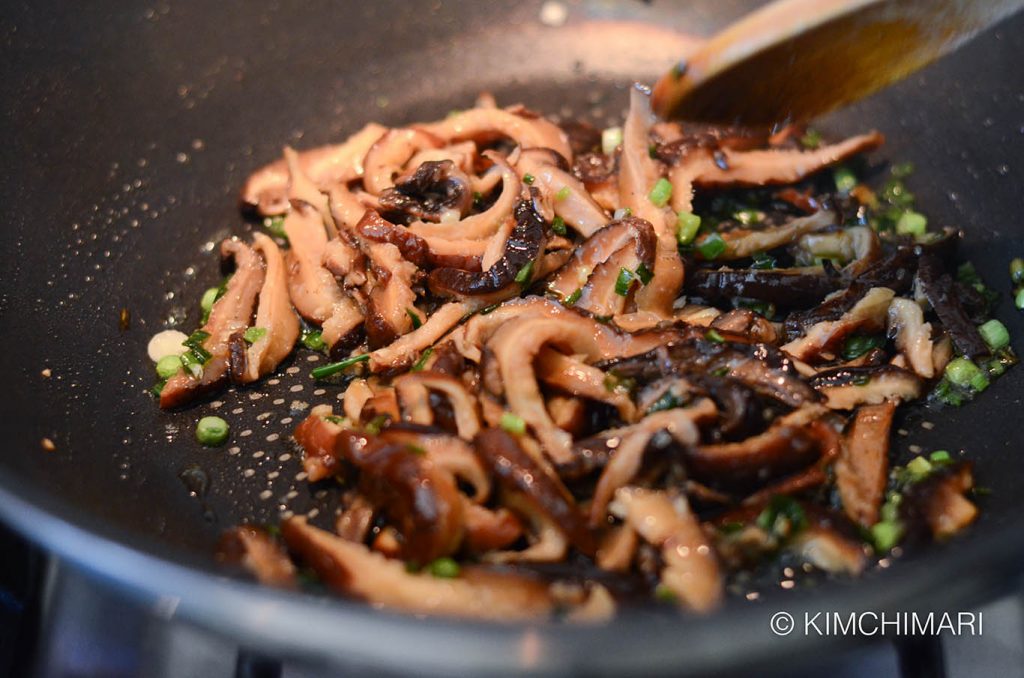
Stir-frying mushrooms for Japchae - Add carrots, onions and wood ear mushrooms and stir-fry for another 2 minutes. Season lightly with salt (1/8 tsp) and pepper (1/8 tsp). Do not fully cook vegetables.

Stir-frying vegetables for Japchae Korean Glass Noodles - Add glass noodles (dangmyeon) to pan. Stir-fry noodles and vegetables together to coat the noodles with oil for about 1 minute. Some noodles will start becoming more transparent and thicker at this point.
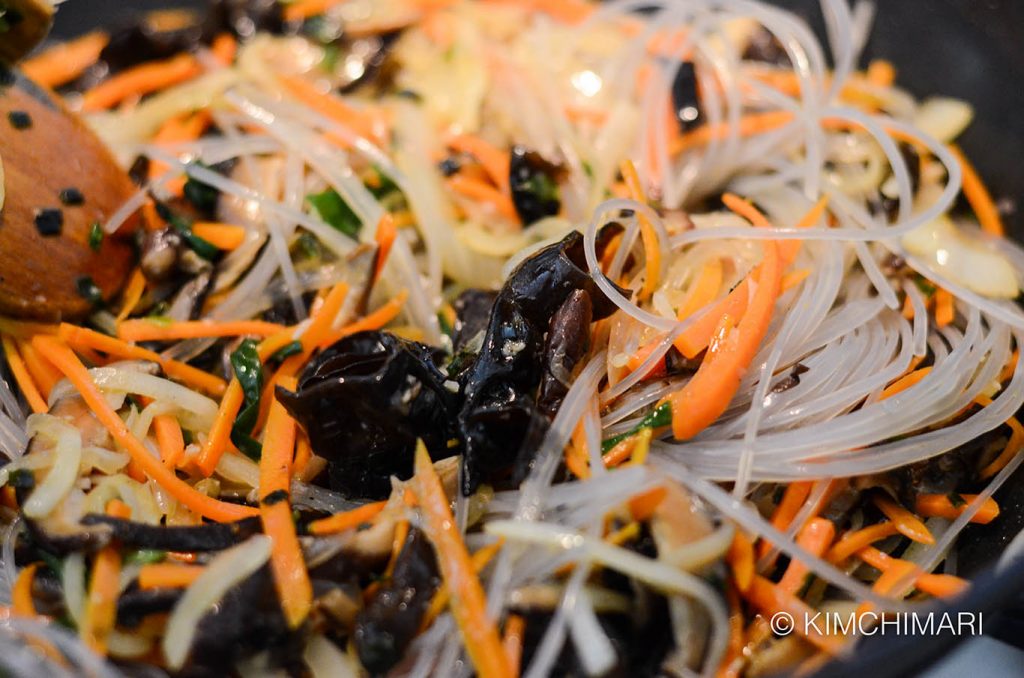
Stir-frying veggies and Japchae noodles - Add 2 Tbs Shitake mushroom water to pan. Stir-fry until noodles are fully cooked (transparent) but still al dente. Probably about 30 seconds to 1 minute.
- Add Japchae sauce to pan and stir-fry for another 2 minutes or so until the sauce is fully absorbed. Quickly taste noodles along with vegetables. Adjust seasoning to taste. Add more soy sauce (1 tsp) and/or sugar (1 tsp) if you want.
- Turn off heat when noodles and vegetables are all cooked.
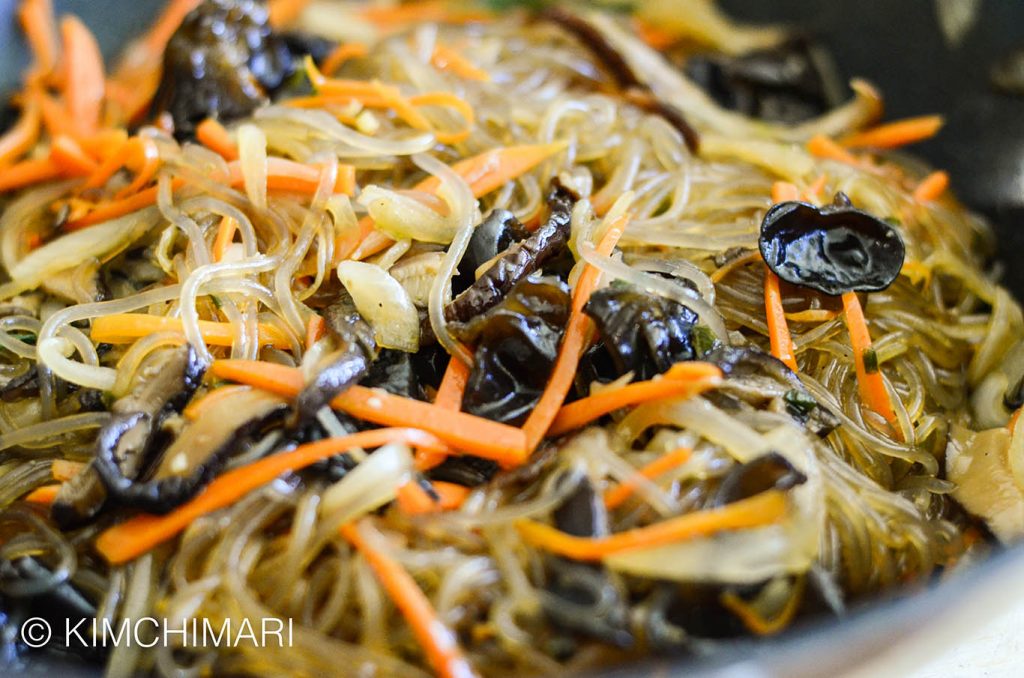
Korean glass noodles stir-fry in one pan recipe - Immediately, add green onions to pan. Green onions will get perfectly cooked in the residual heat. Don’t over cook green onions because we want that to add a freshness to the dish.

One-Pan Korean glass noodles Japchae with green onions - That’s it!! Transfer Korean glass noodles onto a plate and sprinkle sesame seeds on top and another drizzle of sesame oil before serving.
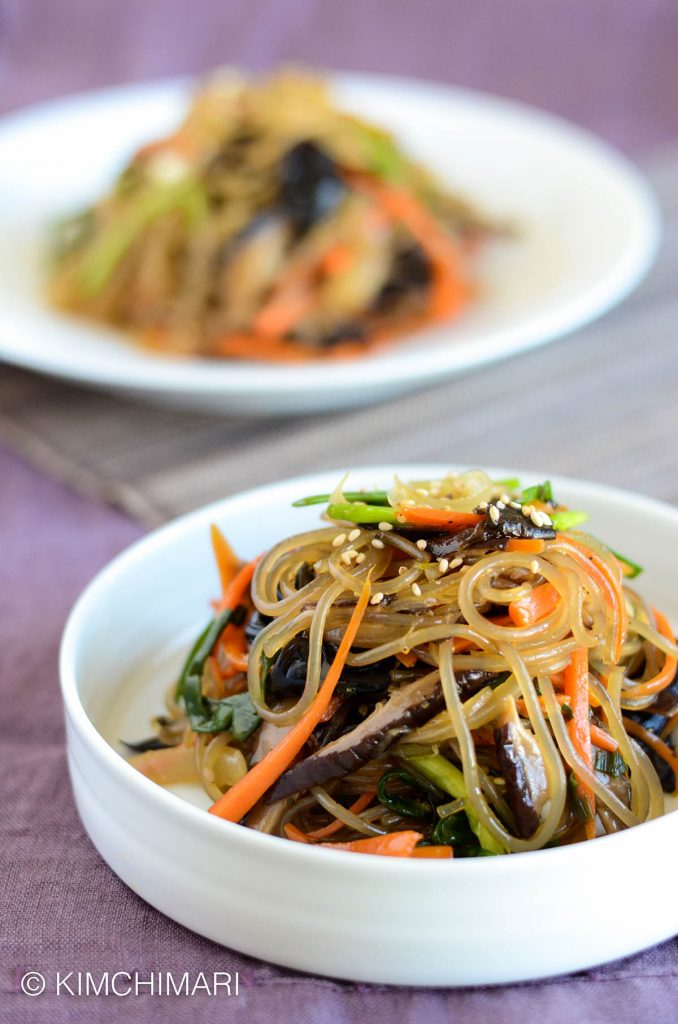
Korean Glass Noodles Japchae with shitake mushrooms 
Korean Glass Noodles – simple one pan Japchae
Tips and Variations
- Key to making delicious Korean glass noodles or Japchae is controlling the amount of liquid during the stir-fry process. Cooking the vegetables too long at low heat will create too much liquid and result in a soggy Japchae. Cooking too quickly at too high a heat may result in burnt noodles.
- Serve hot or at room temperature. Serve with rice and it makes a great one dish meal.
- Use other mushrooms like oyster mushrooms but fresh mushrooms will produce more liquid and not as much flavor so you may want to decrease amount of water added when cooking noodles. I don’t like using common white mushrooms because they have a lot of liquid and too strong a flavor.
- Other vegetables like bell peppers can be stir-fried with carrots and onions.
- You can also add meat – especially marinated beef slices or even bulgogi will work well. Cook it with shitake mushrooms.
- Some add oden (fish cake) or artificial crab meat(맛살 matsal). Not my favorite but you may like it.
Storage
- Leftovers should be stored in fridge and will last for couple days. In summer Japchae can spoil pretty quickly so be careful about leaving it at warm room temp or in inside a hot car.
- Reheat leftover Japchae in pan on low heat for couple minutes while stirring often until all noodles become soft.
Korean Glass Noodles (Japchae) - One Pan Recipe
Ingredients
- 7 oz dry Korean Glass Noodles (당면 Dangmyeon) – doesn’t have to be exact
- 8 dried Shitake mushrooms (3/4 cup fresh shitake mushrooms, sliced)
- 1 cup carrots , julienned
- 1 small onion , thinly sliced
- 6 green onions – cut 4 green onions into 2 inch (5 cm) lengths and chop 2 green onions
- 10 g dried wood ear mushrooms (Mogi Beoseot 목이버섯) or 1 cup fresh wood ear mushrooms
- 2 Tbsp vegetable oil
Marinade for Shitake mushrooms
- 2 tsp soy sauce (jin ganjang 진간장) See my Know your Soy Sauce post for more info
- 1 tsp rice wine
- 1 tsp garlic , chopped
- 1 tsp sugar
- ½ tsp sesame oil
- dash of black pepper
Sauce for Japchae
- 3 Tbsp dark soy sauce (jin ganjang 진간장)
- 4 tsp sugar (4 tsp = 1 Tbsp + 1 tsp)
- 1 Tbsp rice wine or mirin
- 1 Tbsp sesame oil
- 1 Tbsp sesame seeds
- 2 Tbsp Shitake mushroom water from hydrating mushrooms (substitute plain water if using fresh mushrooms)
Instructions
- Soak Korean glass noodles (Dangmyeon or Vermicelli) and any dried mushrooms in room temp water for 2- 3 hours. You can also soak both mushrooms and glass noodles overnight.
- Clean and cut other vegetables: julienne carrots, onions and cut green onions into similar lengths as carrots and onions. Split lengthwise in half if the white part of green onion is thicker than a pencil.
- When mushrooms are fully reconstituted, rinse and clean the mushrooms. When cleaning wood ear mushrooms, make sure the bottom part are free of dirt and white matter by rubbing all of it off with your fingers.
- Drain and squeeze any excess water from shitake mushrooms. DO NOT DISCARD all of the mushroom water. Save 2 Tbs of mushroom water for later. Do not squeeze the mushrooms too much, just one gentle squeeze with your hands is good enough. Just enough so that mushrooms are not dripping water.
- Cut shitake mushrooms into thin slices. Cut wood ear mushrooms into bite size pieces (size of quarters).
- Marinate Shitake mushroom slices with soy sauce, rice wine, garlic, sugar, sesame oil and black pepper.
- Make sauce for Japchae by mixing everything in a bowl except water. Set aside.
- Drain glass noodles and set aside.
- Heat 2 Tbs of vegetable oil on medium high heat in a wok or deep stir-fry pan and stir-fry chopped green onions (about 2 Tbs) for 30 seconds or until cooked but not browned.
- Add marinated Shitake mushrooms to pan and stir-fry for 30 seconds or so.
- Add carrots, onions and wood ear mushrooms and stir-fry for about 2 minutes. Season lightly with salt (1/8 tsp) and pepper (1/8 tsp). Vegetables should not be fully cooked.
- Add glass noodles (dangmyeon) to pan. Stir-fry noodles and vegetables together to coat the noodles with oil for about 1 minute. Some noodles will start to become more transparent and thicker after 1 minute.
- Add 2 Tbs Shitake mushroom water and stir-fry until noodles are fully cooked (transparent) but still al dente. Probably about 30 seconds to 1 minute.
- Add Japchae sauce to pan and stir-fry for another 2 minutes or so until the sauce is fully absorbed. Quickly taste noodles along with vegetables. Adjust seasoning to taste.
- When noodles and vegetables are all cooked, turn off heat.
- Immediately, add green onions to pan and toss. Green onions will get perfectly cooked in the residual heat.
- Sprinkle sesame seeds and another drizzle of sesame oil before serving.
Tips & Notes:
Reheat leftover Japchae in pan on low heat for couple minutes while stirring often until all noodles become soft.
Nutrition Information:
Well, I hope you will enjoy my one-pan Korean Glass Noodles Japchae recipe as much as I do!! I have cooked this recipe 3 times already since I developed it and it has only been couple weeks.
Enjoy!
XOXO
JinJoo
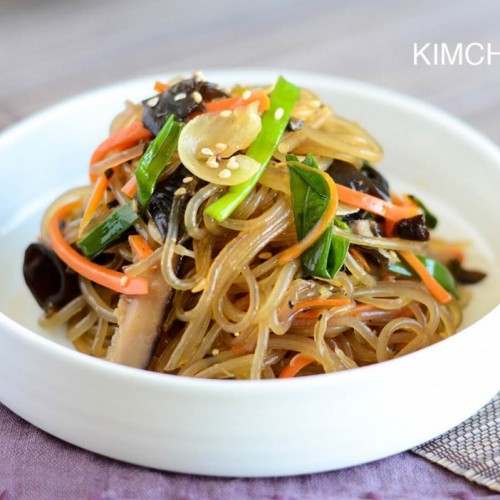
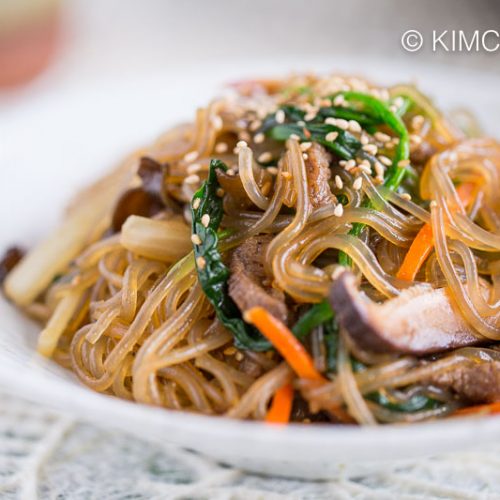

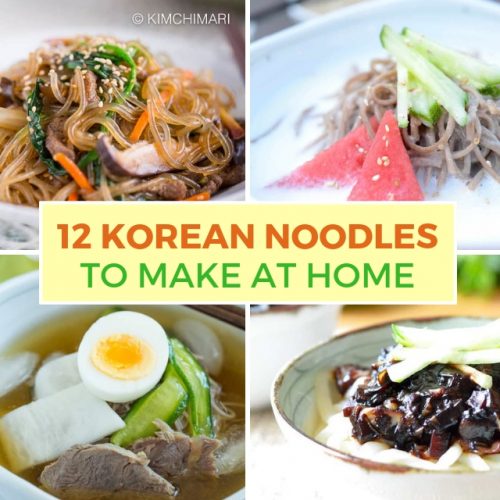
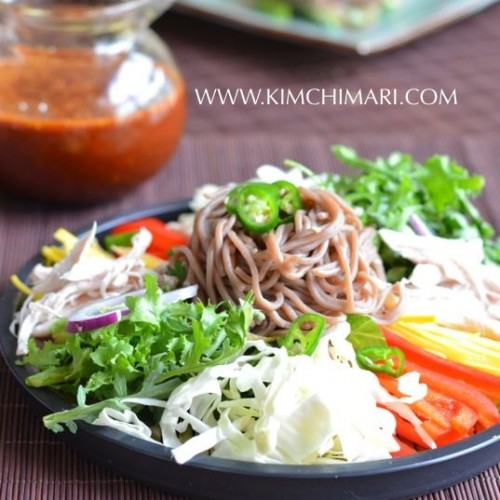
















Hi JinJoo,
My mother made this when I was a kid, adding in a seasoned sautéed spinach. I can’t wait to try my hand at making this recipe! One question…how long should the shiitakes sit in the soy sauce/rice wine marinade?
Thanks!
Hi Mina,
So sorry for the late response. First, FYI, I do have the full authentic version (https://kimchimari.com/japchae/) where spinach is added. This one is a simplified version. 🙂 Shiitakes should sit in the marinade for at least 10 min or so but longer is fine. Enjoy!
My favorite recipe!
Thank you so much Betsy!! 😍
I love these noodles so much that I use them instead of wheat noodles for a number of dishes at this point.